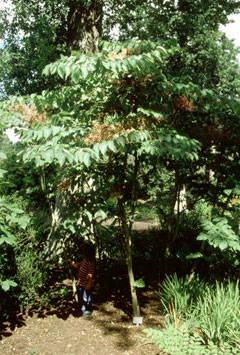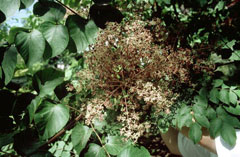 |
|
http://commons.wikimedia.org/wiki/User:KENPEI |
 |
| http://commons.wikimedia.org/wiki/User:Doronenko |
Translate this page:
Summary
Bloom Color: White.
Main Bloom Time: Early summer, Late summer, Mid summer. Form: Upright or erect.
Physical Characteristics

 Aralia Elata is a deciduous Tree growing to 6 m (19ft) by 6 m (19ft) at a medium rate.
Aralia Elata is a deciduous Tree growing to 6 m (19ft) by 6 m (19ft) at a medium rate.
See above for USDA hardiness. It is hardy to UK zone 4 and is not frost tender. It is in flower from August to September. The species is hermaphrodite (has both male and female organs) and is pollinated by Insects.
Suitable for: light (sandy), medium (loamy) and heavy (clay) soils, prefers well-drained soil and can grow in nutritionally poor soil. Suitable pH: mildly acid and neutral soils. It can grow in semi-shade (light woodland) or no shade. It prefers moist soil.
UK Hardiness Map
US Hardiness Map
Synonyms
Dimorphanthus elatus.
Plant Habitats
Woodland Garden Secondary; Sunny Edge; Dappled Shade; Shady Edge;
Edible Uses
Edible Parts: Leaves Shoots
Edible Uses:
Young shoots - cooked[177, 200]. They can also be blanched and used in salads. The young shoots of Aralia elata are a popular wild food in Japan where the tree is known as Taranoki and the shoots as Taranome. In Korea the shoots are called dureup.
References More on Edible Uses
Medicinal Uses
Plants For A Future can not take any responsibility for any adverse effects from the use of plants. Always seek advice from a professional before using a plant medicinally.
Anodyne Cancer Carminative
The roots and stems are anodyne and carminative[147]. All parts of the plant are used for the treatment of rheumatoid arthralgia, coughs, diabetes, jaundice, stomach ulcers and stomach cancers[147, 218].
References More on Medicinal Uses
The Bookshop: Edible Plant Books
Our Latest books on Perennial Plants For Food Forests and Permaculture Gardens in paperback or digital formats.

Edible Tropical Plants
Food Forest Plants for Hotter Conditions: 250+ Plants For Tropical Food Forests & Permaculture Gardens.
More

Edible Temperate Plants
Plants for Your Food Forest: 500 Plants for Temperate Food Forests & Permaculture Gardens.
More

More Books
PFAF have eight books available in paperback and digital formats. Browse the shop for more information.
Shop Now
Other Uses
Landscape Uses: Specimen. Special Features: Not North American native, Blooms are very showy. attracts wildlife. Nectary - Shelter [1-2].
Special Uses
Food Forest
References More on Other Uses
Cultivation details
Prefers a good deep loam and a position in semi-shade but it also succeeds in a sunny position[11, 200]. Requires a sheltered position. Plants are hardier when grown on poorer soils[11, 200]. Prefers an acid soil[184]. Dormant plants are hardy to at least -15°c[184, 200]. The young growth in spring, even on mature plants, is frost-tender and so it is best to grow the plants in a position sheltered from the early morning sun[K]. A very ornamental species, there are a number of named varieties. It is usually a single stemmed shrub, spreading by means of suckers[182]. This species is closely allied to A. chinensis. In Japan Aralia elata is a pioneering plant that often grows where forests have been cleared. In open sunny areas with adequate soil moisture it grows rapidly. The plant is heat tolerant in zones 9 through 1. (Plant Hardiness Zones show how well plants withstand cold winter temperatures.
Plant Heat Zones show when plants would start suffering from the heat.
The Plant Heat Zone map is based on the number of "heat days" experienced in a given area where the temperature climbs to over 86 degrees F (30°C).
At this temperature, many plants begin to suffer physiological damage. Heat Zones range from 1 (no heat days) to 12 (210 or more heat days).
For example Heat Zone. 11-1 indicates that the plant is heat tolerant in zones 11 through 1.) For polyculture design as well as the above-ground architecture (form - tree, shrub etc. and size shown above) information on the habit and root pattern is also useful and given here if available. A clumping plant, forming a colony from shoots away from the crown but with a limited spread [1-2]. The root pattern is suckering with new plants from underground runners away from the plant [1-2].
References Carbon Farming Information and Carbon Sequestration Information
Temperature Converter
Type a value in the Celsius field to convert the value to Fahrenheit:
Fahrenheit:
The PFAF Bookshop
Plants For A Future have a number of books available in paperback and digital form. Book titles include Edible Plants, Edible Perennials, Edible Trees,Edible Shrubs, Woodland Gardening, and Temperate Food Forest Plants. Our new book is Food Forest Plants For Hotter Conditions (Tropical and Sub-Tropical).
Shop Now
Plant Propagation
Seed - best sown as soon as ripe in a cold frame. Stored seed requires 3 - 5 months of cold stratification. Germination usually takes place within 1 - 4 months at 20°c[134]. When large enough to handle, prick the seedlings out into individual pots and grow them on in light shade in a greenhouse for at least their first winter. Once the plants are 25cm or more tall, they can be planted out into their permanent positions, late spring or early summer being the best time to do this. Root cuttings 8cm long, December in a cold frame[11, 78]. Store the roots upside down in sand and pot up in March/April. High percentage[78]. Division of suckers in late winter[11]. Very easy, the suckers can be planted out direct into their permanent positions if required.
Other Names
If available other names are mentioned here
Japanese angelica-tree, Japanese aralia, Dureumnamu, Dureupnamu, Turup, Turupnamu [1-4].
Native Range
TEMPERATE ASIA: Amur, Anhui Sheng, China, Fujian Sheng, Gansu Sheng (south), Guangdong Sheng, Guangxi Zhuangzu Zizhiqu, Guizhou Sheng, Habarovskij kraj, Hebei Sheng, Heilongjiang Sheng, Henan Sheng, Hubei Sheng, Hunan Sheng, Japan, Jiangsu Sheng, Jiangxi Sheng, Jilin Sheng, Korea, Kurile Islands, Liaoning Sheng, Primorye, Sakhalin, Shaanxi Sheng, Shandong Sheng (north), Shanxi Sheng, Sichuan Sheng, Yunnan Sheng, Zhejiang Sheng,Russian Federation.
Weed Potential
Right plant wrong place. We are currently updating this section.
Please note that a plant may be invasive in one area but may not in your area so it’s worth checking.
Conservation Status
IUCN Red List of Threatened Plants Status :

| Related Plants
|
| Latin Name | Common Name | Habit | Height | Hardiness | Growth | Soil | Shade | Moisture | Edible | Medicinal | Other |
| Aralia chinensis | Chinese Angelica Tree, Pumila Spirea, Chinese Astilbe | Shrub | 3.5 |
4-8
| M | LMH | FS | M | 2 | 2 | |
| Aralia continentalis | Manchurian Spikenard | Perennial | 2.0 |
7-10
| | LMH | FS | M | 2 | 0 | |
| Aralia cordata | Udo | Perennial | 1.8 |
4-9
| | LMH | FS | M | 4 | 2 | 0 |
| Aralia elata | Japanese Angelica Tree, Angelica Tree | Tree | 6.0 |
4-9
| M | LMH | SN | M | 3 | 2 | 2 |
| Aralia hispida | Bristly Sarsaparilla | Shrub | 1.0 |
3-7
| | LMH | SN | DM | 2 | 1 | 2 |
| Aralia mandschurica | Manchurian Angelica Tree | Shrub | 3.5 |
4-8
| | LMH | SN | M | 2 | 2 | |
| Aralia nudicaulis | Wild Sarsaparilla | Perennial | 0.4 |
4-8
| | LMH | FS | M | 4 | 3 | 3 |
| Aralia racemosa | American Spikenard | Perennial | 1.8 |
4-8
| | LMH | FS | M | 3 | 3 | 2 |
| Aralia schmidtii | Sakhalin Spikenard | Perennial | 3.0 |
4-8
| | LMH | FS | M | 2 | 0 | |
| Aralia spinosa | Hercule's Club, Aralia spinosa, American Angelica Tree, Hercules' Club, Devil's Walking Stick | Tree | 9.0 |
5-9
| S | LMH | FS | M | 2 | 2 | 2 |
| Eleutherococcus chiisanensis | | Shrub | 0.0 |
-
| | LMH | SN | M | 2 | 0 | |
| Eleutherococcus divaricatus | | Shrub | 3.5 |
5-9
| | LMH | SN | M | 2 | 0 | |
| Eleutherococcus gracylistylus | Wu Jia Pi | Shrub | 3.0 |
5-9
| | LMH | SN | M | 1 | 3 | |
| Eleutherococcus innovans | Taka-No-Tsume | Tree | 6.0 |
6-9
| | LMH | N | M | 1 | 0 | |
| Eleutherococcus japonicus | | Shrub | 3.0 |
-
| | LMH | SN | M | 1 | 0 | |
| Eleutherococcus senticosus | Siberian Ginseng | Shrub | 2.0 |
3-7
| S | LMH | SN | M | 2 | 5 | |
| Eleutherococcus seoulensis | | Shrub | 0.0 |
-
| | LMH | SN | M | 1 | 0 | |
| Eleutherococcus sessiliflorus | | Shrub | 4.5 |
4-8
| | LMH | SN | M | 2 | 3 | |
| Eleutherococcus sieboldianus | Ukogi, Five Leafed Aralia | Shrub | 3.0 |
4-8
| S | LMH | SN | M | 3 | 0 | 2 |
| Eleutherococcus spinosus | | Shrub | 3.0 |
4-8
| | LMH | SN | M | 2 | 2 | 2 |
| Eleutherococcus trifoliatus | | Shrub | 6.0 |
6-9
| | LMH | SN | M | 1 | 1 | |
| Hedera helix | Ivy, English ivy, Algerian ivy, Baltic Ivy, Common Ivy | Climber | 15.0 |
5-11
| M | LMH | FSN | MWe | 0 | 3 | 4 |
| Hedera nepalensis | Nepal Ivy | Climber | 15.0 |
7-10
| M | LMH | FSN | MWe | 0 | 2 | |
| Kalopanax sciadophylloides | | Tree | 0.0 |
-
| | LMH | SN | M | 1 | 0 | |
| Kalopanax septemlobus | Tree Aralia, Castor aralia | Tree | 25.0 |
4-8
| S | LMH | SN | M | 2 | 1 | 2 |
| Kirkophytum lyallii | | Perennial | 0.2 |
-
| | LMH | SN | M | 1 | 0 | |
| Oplopanax horridus | Devil's Club | Shrub | 2.0 |
4-8
| | LMH | FS | M | 2 | 2 | 1 |
| Panax ginseng | Ginseng, Chinese ginseng | Perennial | 0.8 |
5-9
| | LMH | FS | M | 2 | 5 | |
| Panax japonicus | Japanese Ginseng | Perennial | 0.6 |
-
| | LMH | FS | M | 1 | 1 | 1 |
| Panax pseudoginseng | Ginseng, Japanese ginseng | Perennial | 1.0 |
5-9
| S | LMH | FS | M | 1 | 3 | |
|
|
Growth: S = slow M = medium F = fast. Soil: L = light (sandy) M = medium H = heavy (clay). pH: A = acid N = neutral B = basic (alkaline). Shade: F = full shade S = semi-shade N = no shade. Moisture: D = dry M = Moist We = wet Wa = water.
Expert comment
Author
(Miq.)Seem.
Botanical References
1174200
Links / References
For a list of references used on this page please go here
Readers comment